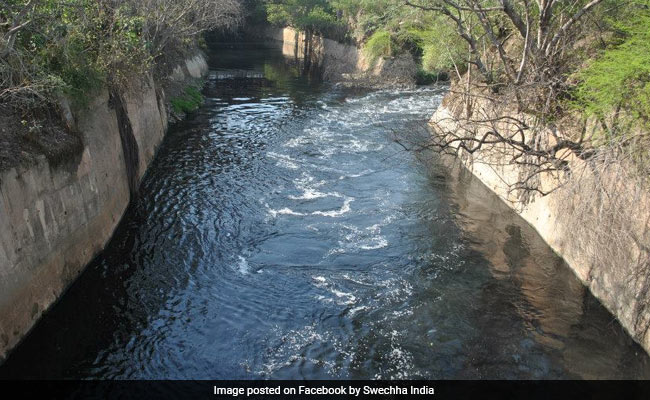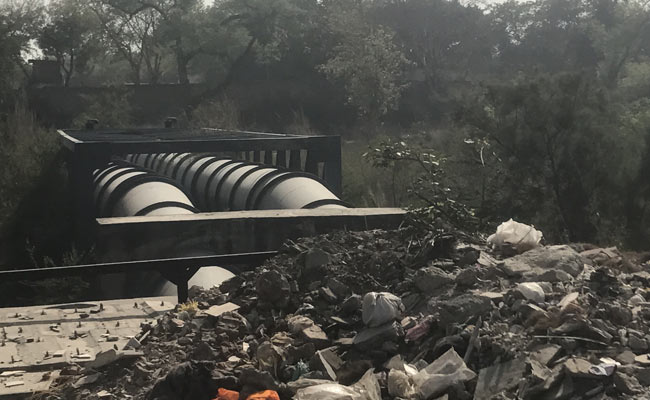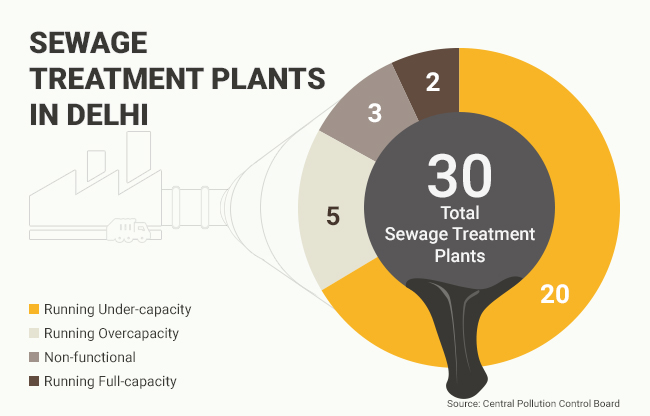Highlights
- Delhi contributes to 70% of the total pollutants found in the Yamuna
- Partially treated or untreated sewage is the primary culprit
- Only 8 of the city's 30 sewage treatment plants currently run full-capacity
New Delhi: With visibly clean water and white sand banks, Cullak Pur (Palla), a village on Delhi’s north-eastern border, offers an untouched, pristine view of the Yamuna as it meanders into the state. However, just a few kilometres downstream, the picture changes completely. Murky, dirty waters and banks heaped with garbage become the new normal. The culprit? Delhi’s wastewater drains which pump a toxic cocktail of domestic sewage, industrial chemical waste and agricultural waste into the river. Shockingly, the river receives almost 70 per cent of its pollutants between Delhi’s Wazirabad and Okhla areas, a 22-kilometre stretch that makes up a mere 2 per cent of the river’s total length.

Cullak Pur, Delhi: When the Yamuna enters Delhi it is relatively clean. Just a few kilometers later, these clear waters turn black
On March 20, earlier this week, in an attempt to ramp up efforts to help revive it, the Yamuna, along with the Ganga, was given the status of a ‘living entity’ by the Uttarakhand High Court. This meant that polluting these rivers would now be the legal equivalent of harming a human being. However, if the Yamuna is to be saved, a lot more will need to be done.
A Little More Than A Drain
Delhi produces a lot of wastewater, nearly 3,800 million litres of it each day, according to CPCB estimates. Nearly half of this makes its way to the Yamuna, untreated. Of the city’s 21 major drains, 18 join the Yamuna.
Watch: ‘Stench at the Yamuna Ghat is Overpowering’: Swachh India Volunteer
What exacerbates this situation is that once it reaches Wazirabad, the river significantly narrows due to the constructed barrages which restrict its flow. This low flow of water coupled with the massive amount of waste makes the Yamuna a little more than a drain and one of the most polluted rivers in the country.
In the same area, the Najafgarh Drain, which is Delhi’s largest and filthiest drain, opens into the Yamuna. This alone contributes to 45 per cent of the pollutants discharged into the river according to a report published by The Energy and Resources Institute (TERI).

The Najafgarh Drain is Delhi’s largest and dirtiest wastewater drain. It is also the first drain that meets the Yamuna
Failed Attempts To Clean
Over the past 22 years, a whopping ₹2,000 crores (including the Yamuna Action Plan) have been allocated to clean the Yamuna with little to show for it.
Also Read: In Agra, Activists Offered Water & Glucose To Dying Yamuna
According to Puneet Srivastava, Policy Manager at WaterAid India, a non-profit working in the clean water and sanitation space, the primary reason for this is the absence of an integrated approach for such activities in India.
“We do have stricter regulations now about dumping effluents in the river. However, because there is no holistic approach or coordination and different bodies are responsible for different areas and aspects, systems for monitoring and accountability are inadequate,” he says.
Despite the number of sewage treatment plans in the Capital, most of the wastewater that is generated makes its way to the Yamuna either untreated or partially treated.
Moreover, of the 30 sewage treatment plants in Delhi, 20 run under capacity and 3 are not functional, according to CPCB.
“There are two problems. In some cases, while the treatment plants exist, the infrastructure to actually get the sewage to them is not present. In other cases, operational problems persist. Either they (the sewage treatment plants) don’t have the funds or they don’t have enough power to operate. This means that either the sewage is just not treated or it is not treated to optimal environmental standards,” Mr Srivastava says.
Read More: Delhi’s Waste Is Responsible For Killing All Aquatic Life In Yamuna River
In May 2016, the Delhi government led by Water Minister Kapil Mishra had presented a detailed ₹840 crore ‘Yamuna Turnaround Plan’ to clean up the river and develop its banks as biodiversity zones over the course of two and a half years.
Also Read: 3 Years Of ‘Namami Gange’: Where Do We Stand?
It is no secret that an unprecedented amount of will and work will need to be done if the Yamuna has to be saved, but if the right steps are taken there is still hope for the river. Till then, the Yamuna in Delhi remains a cautionary tale of the consequences of rapid unchecked urbanisation.

























































pravin mody
March 24, 2017 at 10:51 am
All toilet units in the country must have an adequate size septic tanks under them,either severally or collectively. Similarly all industrial units must have an either or collective units for treating their waste waters.The garbges of vegetables must separately collected by corporation and dispose it by auction for fodder of animals.The flowers of temples and and other religious places to be collected assorted and be auctioned to the essence makers. The bank of the river must be developed as river fronts and boulevards.A central authority to patrol activity of all the separate agencies under one head.Penalties must be enacted by law for omissions.
pravin mody
March 24, 2017 at 11:08 am
Following are the points, (1) All toilets should have adequate septic tanks adequate siza as may be specified by regularization. (2) All industrial units must have either individual or a collective plant for purification of waste waters (3) Corporation must collect garbages of vegetables etc, should be separately collected and auction the same to cattle bearers,(4) All wastages of flowers to be collected from temples and other sources and auction them to the makers of Attar and other perfumes.(5) tha banks should be developed as River fronts with gardens and Boulevards.
CDA
March 26, 2017 at 12:47 pm
What is not reported is, out of the 2000 crores spent in the past 22 years, how many crorephathis it created among politicians and contractors with massive corruption! Shame on us when you see the rest of the world and its progress in essential projects like this.
Kevin
April 2, 2017 at 2:15 am
Only Rs 2000 crores ??? Do people know that this much amount and maybe a lot more is routinely spent in Chennai for cleaning up a river called Coovum.Yet it has become a sewage drain and if you smell a stink in Chennai,you are near the river.And people and politicians fight over CM or political parties as if there is no other issue to be dealt with here.